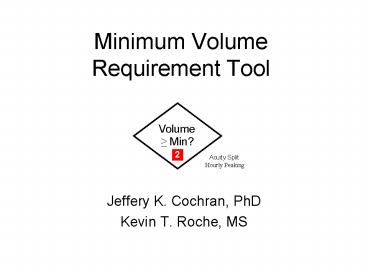Minimum Volume Requirement Tool - PowerPoint PPT Presentation
1 / 11
Title:
Minimum Volume Requirement Tool
Description:
... moves among treatment areas, rarely in front of a doctor, for example, not while ... rOW = (f3 f4) / (f3 f4 f5) rWO = 100% ... – PowerPoint PPT presentation
Number of Views:39
Avg rating:3.0/5.0
Title: Minimum Volume Requirement Tool
1
Minimum Volume Requirement Tool
- Jeffery K. Cochran, PhD
- Kevin T. Roche, MS
2
Analysis Goals
- With this tool, the user will be able to answer
the question Is my facilitys volume sufficient
to support a Split Flow process? - This decision is based on a forecasted planning
volume, patient acuity mix (f1, f2, f3, f4, f5),
and assumed average service times.
3
The Central Concept Two EDs in One
- After a Quick Look registration, patients travel
to either the IPED or the OPED side, depending
upon acuity - In the IPED, all resources come to the patient in
a bed according to traditional clinical practice. - In the OPED, the patient moves among treatment
areas, rarely in front of a doctor, for example,
not while awaiting test results or during
hydration. - Patient splitting is based on an ESI-like acuity
scale where Level 1 and 2 patients go directly to
the IPED and Level 3, 4, and 5 patients are
initially routed to the OPED. - Some Patients will be upgraded from OPED to
IPED. - The next slide shows the OPED and IPED Split ED
areas graphically.
4
Splitting Patient Flow
- Here rIJ is the fraction of patients who flow
from area I to area J. Recall that patient
acuity mix is defined as (f1, f2, f3, f4, f5) and
used for the initial split. - Patients of acuity 5 visit only the OPED
Intake/Discharge area. Patients of acuity 3 and
4 visit Results Waiting and Intake/Discharge (on
the way in and out). - From clinical experience, typically 20 of OPED
patients are upgraded to IPED.
5
Tool 2 Inputs
- Yearly Planning Volume
- This number can be current or future forecasted
volume. - Hourly volume during the peak period will be
determined from this. - Patient Acuity Mix
- These numbers determine the routing of patients
to IPED and OPED.
f1, f2 Patients initially routed to IPED
f3, f4, f5 Patients initially routed to IPED
Intake/Discharge
6
Adjusting for Daily Peaking121 and 2 are
references confirming our time of day peaking
study below.
- ED arrival volume patterns (not overall levels)
are predictable by hour of the day. For example - Volume is stable during the 9 am-9 pm peak at a
multiplier (compared to average daily volume)
1.30
7
Calculating Tool 2 Output
- Hourly ED Arrivals
- The number of patients per hour arriving to the
ED during the peak 12 hours - Arrivals/Hr to Intake/Discharge
- All lower acuity patients are either discharged
after Intake or upgraded to be transferred to the
IPED.
Lower acuity patients see a doctor in this area
twice.
8
The EXCEL Tool 2
9
Using Tool 2 Results
- An average hourly Intake/Discharge volume of gt
4.05 patients will support a single doctor at 70
utilization during the peak hours which provides
good door-to-doc times. - If your results cell is green, at least one
provider is required on the OPED side. Tool 5
will estimate how much space is required and Tool
6 how many providers. - If the results cell is red, implementing split
flow is more complicated. Although there is not
enough business to keep the area fully busy, the
principle of patients do not own a bed can
still be used and lower acuity patients may wait
for results or be hydrated in waiting spaces
rather than full service IPED beds. These ideas
have been implemented by individual physicians
and hospitals, but are not directly supported by
this Toolkit.
10
Links to Next Tools
- Re-enter, dont copy and paste,
- Patient Acuity Mix into
- Needed to divide patient flow
- Re-enter, dont copy and paste,
- Daily Planning Volume into
- Used to capacitate areas in the Split Flow model
3
4
5
5
11
References
- 1 Green LV, Soares J, Giglio JF, Green RA.
Using queueing theory to increase the
effectiveness of emergency department provider
staffing. Academic Emergency Medicine
20061361-68. - 2 HealthTech Briefing Report. Key trends in
emergency and trauma services. Health Technology
Center Oct 2006. http//www.healthtechcenter.org/.































